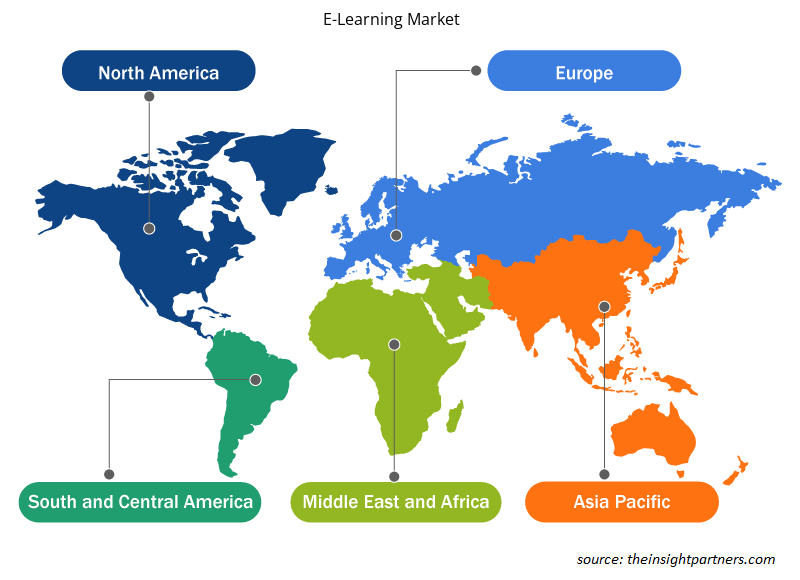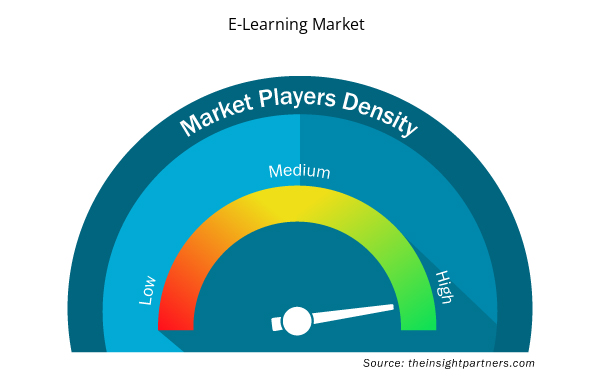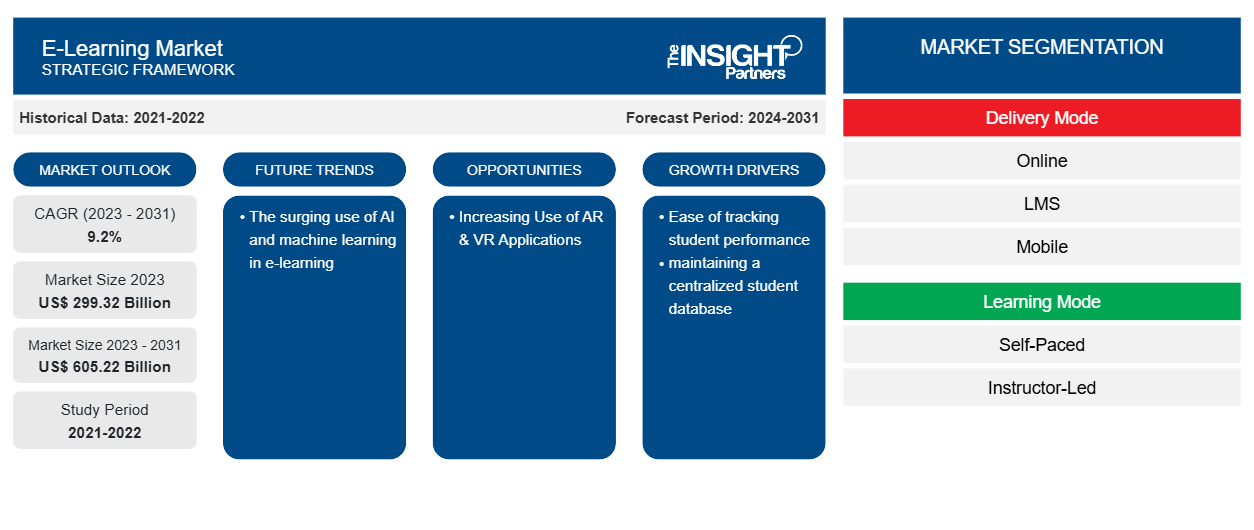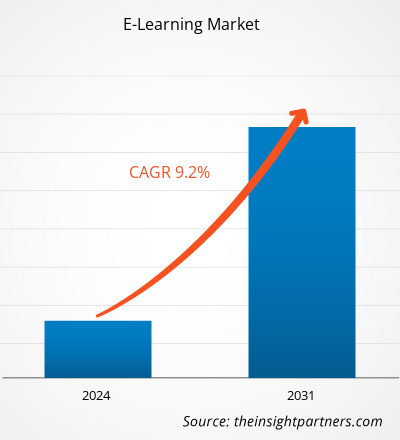Der E-Learning-Markt soll von 299,32 Milliarden US-Dollar im Jahr 2023 auf 605,22 Milliarden US-Dollar im Jahr 2031 anwachsen.Es wird erwartet, dass der Markt zwischen 2023 und 2031 eine durchschnittliche jährliche Wachstumsrate (CAGR) von 9,2 % verzeichnet. Der zunehmende Einsatz von KI und maschinellem Lernen im E-Learning dürfte ein wichtiger Trend auf dem Markt bleiben.
E-Learning-Marktanalyse
Online- und technologiebasierte Bildung hat die Präsenzbildung in Bezug auf Kosten, Zugänglichkeit, Zeit und Komfort überholt. Studenten können ihre Fähigkeiten verbessern, indem sie sich für Kurse von Top-Experten und Universitäten weltweit anmelden. Neben Studenten sind Berufstätige ein weiteres wichtiges Zielsegment für digitale Lernorganisationen. Online- Zertifizierungen sind im heutigen wettbewerbsorientierten Unternehmensumfeld immer beliebter geworden. In verschiedenen Branchen, darunter IT, BPOs, KPOs und Start-ups, wird eine kontinuierliche Verbesserung der Fähigkeiten erwartet. Unternehmensmitarbeiter nehmen zunehmend an Online-Kursen teil, um auf dem Laufenden zu bleiben, während die meisten Berufstätigen Zertifikate für ihre Arbeit verlangen.
E-Learning-Marktübersicht
Der Markt für digitales Lernen wächst in Entwicklungsländern rasant, und viele Start-ups drängen in diesen Sektor. Der Sektor des digitalen Lernens wird von Faktoren wie zunehmender Internetnutzung, Zeitbeschränkungen, geografischen Hindernissen und geringeren Kosten für Online-Schulungen angetrieben. Diese Faktoren fördern das Lernen im eigenen Tempo und erweitern seinen Umfang. Da die Nachfrage nach Qualitätszertifizierungen steigt, wenden sich immer mehr Menschen Online-Lernprogrammen zu.
Passen Sie diesen Bericht Ihren Anforderungen an
Sie erhalten kostenlos individuelle Anpassungen an jedem Bericht, einschließlich Teilen dieses Berichts oder einer Analyse auf Länderebene, eines Excel-Datenpakets sowie tolle Angebote und Rabatte für Start-ups und Universitäten.
- Holen Sie sich die wichtigsten Markttrends aus diesem Bericht.Dieses KOSTENLOSE Beispiel umfasst eine Datenanalyse von Markttrends bis hin zu Schätzungen und Prognosen.
Treiber und Chancen des E-Learning-Marktes
Steigende Anzahl vernetzter Geräte und zunehmende Internetdurchdringung begünstigen den Markt
Die Nachfrage nach vernetzten Geräten wie Tablets, Laptops und Smartphones steigt weltweit. Die Nachfrage wird durch Homeoffice- und Lernszenarien noch weiter angekurbelt. Da Schüler aufgrund der Ausgangssperren und der Maßnahmen zur sozialen Distanzierung aufgrund der COVID-19-Pandemie nicht an der Schule oder am Unterricht teilnehmen konnten, wurde ihr Unterricht online durchgeführt, was letztendlich die Nachfrage nach Smartphones und Laptops ankurbelte. Darüber hinaus hat die Entwicklung der Telekommunikationsdienste weltweit zu einer Zunahme der Internetdurchdringung geführt, selbst in den entlegensten Gebieten der Welt, was den globalen E-Learning-Markt ergänzt.
Zunehmende Nutzung von AR- und VR-Anwendungen
In den letzten Jahren haben Augmented Reality (AR) und Virtual Reality (VR)-Technologien in der Bildungs- und Ausbildungsbranche als hervorragende Methoden zur Verbesserung des Lernerlebnisses an Attraktivität gewonnen. AR und VR ermöglichen Fernunterricht und flexibles Lernen, sodass Schüler von überall auf der Welt auf Schulungsmaterialien und Simulationen zugreifen können. Dies kann insbesondere dann nützlich sein, wenn Schüler nicht an persönlichen Schulungen teilnehmen können.
Segmentierungsanalyse des E-Learning-Marktberichts
Wichtige Segmente, die zur Ableitung der E-Learning-Marktanalyse beigetragen haben, sind Bereitstellungsmodus, Lernmodus und Endbenutzer.
- Basierend auf der Bereitstellungsart ist der E-Learning-Markt in Online, LMS, Mobil und Sonstige unterteilt. Das Online-Segment hatte im Jahr 2023 einen größeren Marktanteil.
- Nach Lernmodus ist der Markt in selbstgesteuertes Lernen und lehrergeführtes Lernen segmentiert.
- Nach Endnutzern ist der Markt in akademische und Unternehmensbereiche segmentiert. K-12 und höhere Bildungseinrichtungen sind die wichtigsten Untersegmente des Endnutzersegments.
E-Learning-Marktanteilsanalyse nach Geografie
Der geografische Umfang des E-Learning-Marktberichts ist hauptsächlich in fünf Regionen unterteilt: Nordamerika, Asien-Pazifik, Europa, Naher Osten und Afrika sowie Süd- und Mittelamerika.
Nordamerika dominierte den E-Learning-Marktanteil im Jahr 2023. Laut dem HurixDigital-Bericht 2023 sind die USA eines der weltweit führenden Länder hinsichtlich der erfolgreichen Implementierung von E-Learning im Bildungswesen.
Regionale Einblicke in den E-Learning-Markt
Die regionalen Trends und Faktoren, die den E-Learning-Markt im Prognosezeitraum beeinflussen, wurden von den Analysten von Insight Partners ausführlich erläutert. In diesem Abschnitt werden auch E-Learning-Marktsegmente und -Geografie in Nordamerika, Europa, im asiatisch-pazifischen Raum, im Nahen Osten und Afrika sowie in Süd- und Mittelamerika erörtert.

- Holen Sie sich die regionalspezifischen Daten für den E-Learning-Markt
Umfang des E-Learning-Marktberichts
| Berichtsattribut | Details |
|---|---|
| Marktgröße im Jahr 2023 | 299,32 Milliarden US-Dollar |
| Marktgröße bis 2031 | 605,22 Milliarden US-Dollar |
| Globale CAGR (2023 - 2031) | 9,2 % |
| Historische Daten | 2021-2022 |
| Prognosezeitraum | 2024–2031 |
| Abgedeckte Segmente | Nach Liefermodus
|
| Abgedeckte Regionen und Länder | Nordamerika
|
| Marktführer und wichtige Unternehmensprofile |
|
Dichte der E-Learning-Marktakteure: Deren Auswirkungen auf die Geschäftsdynamik
Der E-Learning-Markt wächst rasant, angetrieben durch die steigende Nachfrage der Endnutzer aufgrund von Faktoren wie sich entwickelnden Verbraucherpräferenzen, technologischen Fortschritten und einem größeren Bewusstsein für die Vorteile des Produkts. Mit steigender Nachfrage erweitern Unternehmen ihr Angebot, entwickeln Innovationen, um die Bedürfnisse der Verbraucher zu erfüllen, und nutzen neue Trends, was das Marktwachstum weiter ankurbelt.
Die Marktteilnehmerdichte bezieht sich auf die Verteilung der Firmen oder Unternehmen, die in einem bestimmten Markt oder einer bestimmten Branche tätig sind. Sie gibt an, wie viele Wettbewerber (Marktteilnehmer) in einem bestimmten Marktraum im Verhältnis zu seiner Größe oder seinem gesamten Marktwert präsent sind.
Die wichtigsten auf dem E-Learning-Markt tätigen Unternehmen sind:
- Kursra
- edX
- LinkedIn Learning
- Fähigkeiten teilen
- Skillsoft
- Udacity
Haftungsausschluss : Die oben aufgeführten Unternehmen sind nicht in einer bestimmten Reihenfolge aufgeführt.

- Überblick über die wichtigsten Akteure auf dem E-Learning-Markt
Neuigkeiten und aktuelle Entwicklungen zum E-Learning-Markt
Der E-Learning-Markt wird durch die Erhebung qualitativer und quantitativer Daten aus Primär- und Sekundärforschung bewertet, die wichtige Unternehmenspublikationen, Verbandsdaten und Datenbanken umfasst. Nachfolgend sind einige der Entwicklungen auf dem E-Learning-Markt aufgeführt:
- Die William Woods University (WWU) hat heute offiziell eine Vereinbarung mit Coursera, einer globalen Online-Lernplattform, bekannt gegeben, die den Zugang zu digitalen Inhalten, die für die heutige Arbeitswelt relevant sind, erheblich erweitern wird und WWU-Studenten, Mitarbeitern, Alumni und Universitätspartnern Kompetenztraining und branchenweit anerkannte Zertifizierungen für gefragte berufliche Fähigkeiten bietet. Die neue Partnerschaft wird es William Woods ermöglichen, auf Coursera mit Online-Kursen und Zertifikaten in einer Vielzahl von Disziplinen von über 325 Top-Universitäten und Unternehmen zu lernen und diese in den Lehrplan der Universität einzubinden, wodurch die akademische Erfahrung und die Arbeitsmarktfähigkeit jedes WWU-Studenten weiter verbessert werden. (Quelle: William Woods University, Pressemitteilung, Februar 2024)
- edX und Degreed haben eine erweiterte strategische Partnerschaft angekündigt, um Organisationen erstklassige Bildungsinhalte und Plattformlösungen bereitzustellen, die kompetenzbasiertes Lernen fördern. Jetzt ist edX For Business – eine erstklassige Inhaltslösung für Organisationen, die wirkungsvollere Lern- und Entwicklungsprogramme durchführen möchten – für Organisationen und ihre Mitarbeiter direkt innerhalb der Degreed-Plattform verfügbar. Dies ist Ausdruck einer konzertierten Anstrengung, neu zu definieren, wie Unternehmen Talente auf allen Ebenen ihrer Belegschaft schulen, weiterbilden und halten. (Quelle: edX, Pressemitteilung, Dezember 2023)
Abdeckung und Ergebnisse des E-Learning-Marktberichts
Der Bericht „E-Learning-Marktgröße und -Prognose (2021–2031)“ bietet eine detaillierte Analyse des Marktes, die die folgenden Bereiche abdeckt:
- E-Learning-Marktgröße und -Prognose auf globaler, regionaler und Länderebene für alle wichtigen Marktsegmente, die im Rahmen des Berichts abgedeckt sind
- E-Learning-Markttrends sowie Marktdynamik wie Treiber, Einschränkungen und wichtige Chancen
- Detaillierte PEST/Porters Five Forces- und SWOT-Analyse
- E-Learning-Marktanalyse mit wichtigen Markttrends, globalen und regionalen Rahmenbedingungen, wichtigen Akteuren, Vorschriften und aktuellen Marktentwicklungen
- Branchenlandschaft und Wettbewerbsanalyse mit Marktkonzentration, Heatmap-Analyse, prominenten Akteuren und aktuellen Entwicklungen für den E-Learning-Markt
- Detaillierte Firmenprofile
- Historische Analyse (2 Jahre), Basisjahr, Prognose (7 Jahre) mit CAGR
- PEST- und SWOT-Analyse
- Marktgröße Wert/Volumen – Global, Regional, Land
- Branche und Wettbewerbsumfeld
- Excel-Datensatz


- Parking Management Market
- Oxy-fuel Combustion Technology Market
- Pressure Vessel Composite Materials Market
- Sports Technology Market
- Artificial Intelligence in Defense Market
- Human Microbiome Market
- Personality Assessment Solution Market
- Sweet Potato Market
- Flexible Garden Hoses Market
- Molecular Diagnostics Market

Report Coverage
Revenue forecast, Company Analysis, Industry landscape, Growth factors, and Trends

Segment Covered
This text is related
to segments covered.

Regional Scope
North America, Europe, Asia Pacific, Middle East & Africa, South & Central America

Country Scope
This text is related
to country scope.
Häufig gestellte Fragen
North America dominated the E-Learning market in 2023.
Ease of tracking student performance and maintaining a centralized student database are expected to drive the E-Learning market.
The surging use of AI and machine learning in e-learning is likely to remain a key trends in the market.
Coursera, edX, LinkedIn Learning, Skillshare, Skillsoft, Udacity, Khan Academy, Learning Pool, Pluralsight, Blackboard, Adobe Inc, Aptara, AllenComm, Plato eLearning, LLC, FutureLearn, Infopro Learning, Instructure, iSpring Solutions, Absorb, Allen Interactions Inc, Cisco Systems Inc are among the leading payers operating in the E-Learning market.
The E-Learning market size is projected to reach US$ 605.22 billion by 2031
The E-Learning market is expected to register a CAGR of 9.2% during 2023–2031
Trends and growth analysis reports related to Technology, Media and Telecommunications : READ MORE..
The Insight Partners performs research in 4 major stages: Data Collection & Secondary Research, Primary Research, Data Analysis and Data Triangulation & Final Review.
- Data Collection and Secondary Research:
As a market research and consulting firm operating from a decade, we have published and advised several client across the globe. First step for any study will start with an assessment of currently available data and insights from existing reports. Further, historical and current market information is collected from Investor Presentations, Annual Reports, SEC Filings, etc., and other information related to company’s performance and market positioning are gathered from Paid Databases (Factiva, Hoovers, and Reuters) and various other publications available in public domain.
Several associations trade associates, technical forums, institutes, societies and organization are accessed to gain technical as well as market related insights through their publications such as research papers, blogs and press releases related to the studies are referred to get cues about the market. Further, white papers, journals, magazines, and other news articles published in last 3 years are scrutinized and analyzed to understand the current market trends.
- Primary Research:
The primarily interview analysis comprise of data obtained from industry participants interview and answers to survey questions gathered by in-house primary team.
For primary research, interviews are conducted with industry experts/CEOs/Marketing Managers/VPs/Subject Matter Experts from both demand and supply side to get a 360-degree view of the market. The primary team conducts several interviews based on the complexity of the markets to understand the various market trends and dynamics which makes research more credible and precise.
A typical research interview fulfils the following functions:
- Provides first-hand information on the market size, market trends, growth trends, competitive landscape, and outlook
- Validates and strengthens in-house secondary research findings
- Develops the analysis team’s expertise and market understanding
Primary research involves email interactions and telephone interviews for each market, category, segment, and sub-segment across geographies. The participants who typically take part in such a process include, but are not limited to:
- Industry participants: VPs, business development managers, market intelligence managers and national sales managers
- Outside experts: Valuation experts, research analysts and key opinion leaders specializing in the electronics and semiconductor industry.
Below is the breakup of our primary respondents by company, designation, and region:

Once we receive the confirmation from primary research sources or primary respondents, we finalize the base year market estimation and forecast the data as per the macroeconomic and microeconomic factors assessed during data collection.
- Data Analysis:
Once data is validated through both secondary as well as primary respondents, we finalize the market estimations by hypothesis formulation and factor analysis at regional and country level.
- Macro-Economic Factor Analysis:
We analyse macroeconomic indicators such the gross domestic product (GDP), increase in the demand for goods and services across industries, technological advancement, regional economic growth, governmental policies, the influence of COVID-19, PEST analysis, and other aspects. This analysis aids in setting benchmarks for various nations/regions and approximating market splits. Additionally, the general trend of the aforementioned components aid in determining the market's development possibilities.
- Country Level Data:
Various factors that are especially aligned to the country are taken into account to determine the market size for a certain area and country, including the presence of vendors, such as headquarters and offices, the country's GDP, demand patterns, and industry growth. To comprehend the market dynamics for the nation, a number of growth variables, inhibitors, application areas, and current market trends are researched. The aforementioned elements aid in determining the country's overall market's growth potential.
- Company Profile:
The “Table of Contents” is formulated by listing and analyzing more than 25 - 30 companies operating in the market ecosystem across geographies. However, we profile only 10 companies as a standard practice in our syndicate reports. These 10 companies comprise leading, emerging, and regional players. Nonetheless, our analysis is not restricted to the 10 listed companies, we also analyze other companies present in the market to develop a holistic view and understand the prevailing trends. The “Company Profiles” section in the report covers key facts, business description, products & services, financial information, SWOT analysis, and key developments. The financial information presented is extracted from the annual reports and official documents of the publicly listed companies. Upon collecting the information for the sections of respective companies, we verify them via various primary sources and then compile the data in respective company profiles. The company level information helps us in deriving the base number as well as in forecasting the market size.
- Developing Base Number:
Aggregation of sales statistics (2020-2022) and macro-economic factor, and other secondary and primary research insights are utilized to arrive at base number and related market shares for 2022. The data gaps are identified in this step and relevant market data is analyzed, collected from paid primary interviews or databases. On finalizing the base year market size, forecasts are developed on the basis of macro-economic, industry and market growth factors and company level analysis.
- Data Triangulation and Final Review:
The market findings and base year market size calculations are validated from supply as well as demand side. Demand side validations are based on macro-economic factor analysis and benchmarks for respective regions and countries. In case of supply side validations, revenues of major companies are estimated (in case not available) based on industry benchmark, approximate number of employees, product portfolio, and primary interviews revenues are gathered. Further revenue from target product/service segment is assessed to avoid overshooting of market statistics. In case of heavy deviations between supply and demand side values, all thes steps are repeated to achieve synchronization.
We follow an iterative model, wherein we share our research findings with Subject Matter Experts (SME’s) and Key Opinion Leaders (KOLs) until consensus view of the market is not formulated – this model negates any drastic deviation in the opinions of experts. Only validated and universally acceptable research findings are quoted in our reports.
We have important check points that we use to validate our research findings – which we call – data triangulation, where we validate the information, we generate from secondary sources with primary interviews and then we re-validate with our internal data bases and Subject matter experts. This comprehensive model enables us to deliver high quality, reliable data in shortest possible time.


 Holen Sie sich ein kostenloses Muster für diesen Bericht
Holen Sie sich ein kostenloses Muster für diesen Bericht